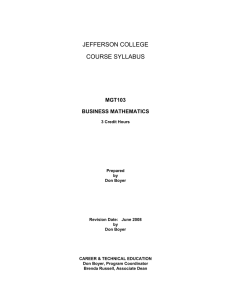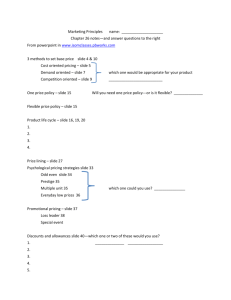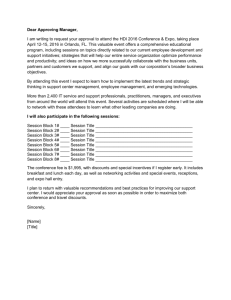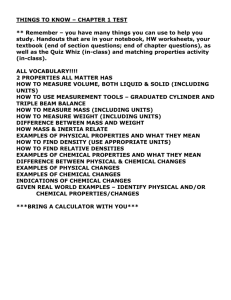JEFFERSON COLLEGE COURSE SYLLABUS
advertisement
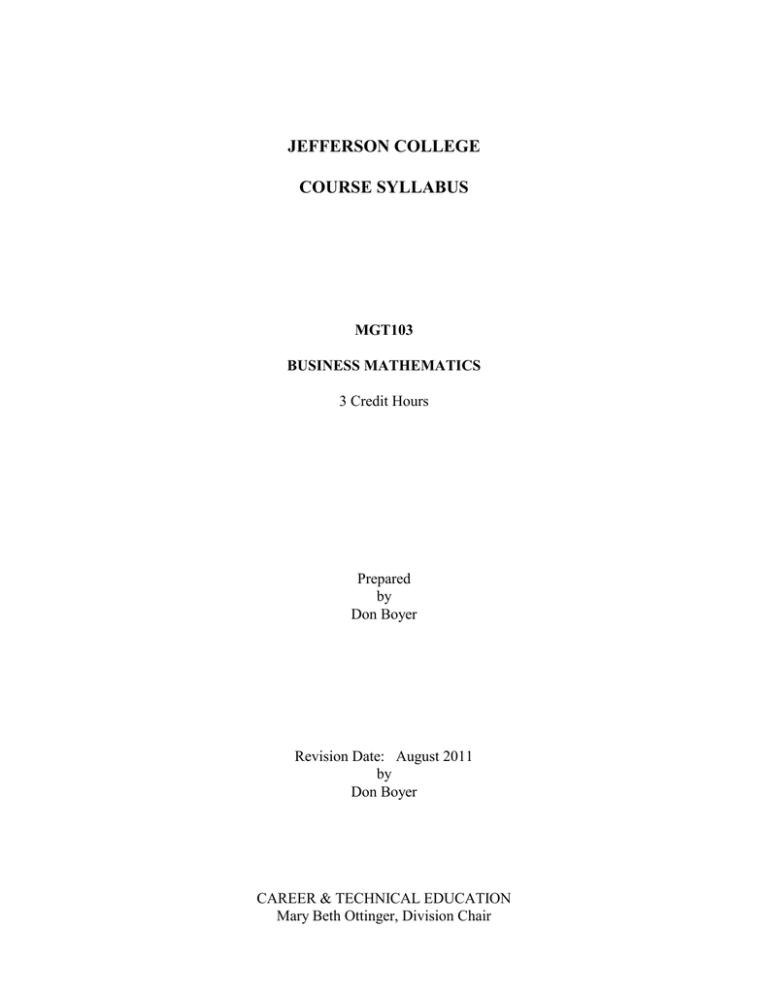
JEFFERSON COLLEGE COURSE SYLLABUS MGT103 BUSINESS MATHEMATICS 3 Credit Hours Prepared by Don Boyer Revision Date: August 2011 by Don Boyer CAREER & TECHNICAL EDUCATION Mary Beth Ottinger, Division Chair Mgt103 Business Mathematics I. CATALOG DESCRIPTION Prerequisite: none 3 semester hours credit Business Mathematics deals with applying math to business situations. Topics covered include trade and cash discounts, merchandise pricing, depreciation, financial statement analysis, and simple and compound interest. II. EXPECTED LEARNING OUTCOMES This course involves an examination of the mathematical skills needed and the techniques used within the field of Business. The objectives of the course are: Expected Learning Outcome To develop the mathematical and computational skills necessary for subsequent business courses and actual business applications. To obtain a working knowledge of the formulas necessary to solve problems dealing with percentages. To become competent in the application of mathematics to the buying and selling of merchandise. To develop an understanding of the mathematics use in determining simple and compound interest. To become aware of and apply the use of financial statements in the analysis of business problems. To apply business mathematics to everyday life in the role of an informed consumer. Assessment Students will define the impact of course material to other course work and real world business applications through in-class exercises, discussions, quizzes, and exams. Students will be able to give examples of how the Percentage Formula is used in Business as well as individual applications through in-class exercises, ,worksheets quizzes, and exams Students will place a price on products using both cost based and retail based pricing methods and then analyze the impact of each through in-class exercises, worksheets, quizzes, and exams. Students will perform a number of calculations with different compounding periods and then compare those calculations to simple interest calculations through in-class exercises, worksheets, quizzes, and exams Students will perform vertical, horizontal and ratio analysis from information found on Income Statements and Balance Sheets through in-class exercises, worksheets, and exams Students will be able to complete a bank reconciliation and determine how interest is calculated on credit cards through in-class exercises, worksheets, and exams III. COURSE OUTLINE and UNIT OBJECTIVES A. Introduction and a review of basic mathematical calculations 1. B. Reading and rounding of whole numbers, review of fractions, reading and rounding of decimal numbers, converting fractions to decimals and converting decimals to fractions. Bank Records 1. 2. Explores the proper way to fill out forms used with a checking account; the check, check register, check stub, and deposit slip. The proper technique used to perform a bank reconciliation C. Review Basic Math and Bank Records To review basic math calculations and to become familiar with the bank records involved with a checking account: 1. Whole numbers, fractions, decimals 2. Checking account forms 3. Bank reconciliation D. Percents and their Applications in Business 1. 2. E. Invoices, Trade and Cash Discounts 1. 2. F. Define a percent and show the relationship of percents to decimals and fractions and how they are converted from one to another. Define the components of the percentage formula and the correct formula to use in order to obtain each of the components; Part, Rate, and Base. Define trade discounts and why they are given to retailers and wholesalers. Define the difference between single trade discounts, and chain/series discounts and be able to calculate each type. Define cash discounts and the components involved with cash discounts. Be able to calculate cash discounts, determine discount periods and credit periods. Become aware of freight terms, and how partial payments can be used to take advantage of cash discounts. Review Percents, Percentage Formula , Trade Discounts, and Cash Discounts To become familiar with percents and how they are used in trade and cash discounts: 1. Percentage formula 2. Single and chain discounts 3. Cash discounts G. Retail Pricing, (Markup and Markdown) 1. 2. 3. H. Demonstrate the two different methods used by retailers, wholesalers, and manufacturers to determine the price on their merchandise.(cost-based and retail-based pricing). Define markdowns and show the proper methods of calculating both onetime markdowns and a series of markdowns. Demonstrate the method used in pricing perishable products and the components that must be considered. Review Retail Pricing To learn the different methods used in pricing products and the marking down of products: 1. Cost-based pricing 2. Retail based pricing 3. Pricing perishable products 4. Markdowns I. Simple Interest and Promissory Notes 1. Define simple interest and the variables involved with simple interest. Calculate each variable with the appropriate formula. Variables included are interest, principal, rate, and time. To be able to calculate simple interest, other variables of simple interest, and bank discount: 1. Interest 2. Principal 3. Rate 4. Time J. Compound Interest and Present Value of Money 1. 2. Define compound interest and how it compares to simple interest. Demonstrate the different methods of calculating compound interest. (formula method and table method). Define and calculate effective rate. Define and calculate the present value of money using the table method. To be able to calculate compound interest, effective rate and the present value of money: 1. Maturity value 2. Compound interest 3. Effective rate 4. Present value K. Review Simple Interest and Compound Interest L. Depreciation 1. M. An exploration of the different methods used in determining depreciation expense. Methods covered include: straight line, units of production, sum of the years digits, double declining balance, modified accelerated cost recovery system. Review Depreciation To become familiar with depreciation and methods used in calculating depreciation: 1. Straight line 2. Units of production 3. Sum of the years digits 4. Double declining balance 5. MACRS N. Financial Statements and Ratios 1. 2. O. An overview of the income statement and balance sheet and why each statement is important to a business. Define vertical and horizontal analysis and perform each on a financial statement. Define financial ratios and calculate four basic ratios. (current ratio, quick ratio, operating ratio, and gross profit margin ratio. Review Financial Statements and Ratios To become familiar with the income statement, balance sheet, and the information that can be derived from each: 1. Vertical analysis 2. Horizontal analysis 3. Ratio analysis IV. METHOD OF INSTRUCTION A.Lecture B.Worksheets V. REQUIRED TEXTBOOKS Contemporary Mathematics for Business & Consumers, 6th. Edition, Robert A. Brechner, South Western/Cenage Learning 2012 VI. REQUIRED MATERIALS Notebook, paper, pencil, calculator, folder VII. SUPPLEMENTAL REFERENCES None VIII. METHOD OF EVALUATION Six textbook exams Projects Homework assignments Attendance IX. 100 points each 80% of grade 20%of grade ADA STATEMENT Any student requiring special accommodations should inform the instructor and the Coordinator of Disability Support Services (Library; phone 636-797-3000, ext. 169). X. ACADEMIC HONESTY STATEMENT All students are responsible for complying with campus policies as stated in the Student Handbook (see College Website, http://www.jeffco.edu/jeffco/index.php?option=com_weblinks&catid=26&Itemid=84
